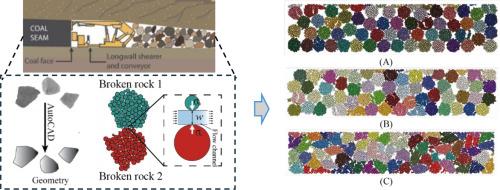崩落带压实过程中破碎块体几何形状对力学响应和流体流动特性的影响
IF 4.6
2区 工程技术
Q2 ENGINEERING, CHEMICAL
引用次数: 0
摘要
地下开采在资源开采和清洁能源转型中发挥着举足轻重的作用,但垮落带的安全管理仍然是一个主要挑战。研究了破碎岩石几何形状对采空区破碎岩石力学响应和流体流动特性的影响。通过模拟三种不同的碎片几何形状,对应力应变测量、岩石再破碎和尺寸分布变化进行了表征。结果表明,破碎岩石几何形状的不规则程度越高,材料对压实越敏感,导致破碎程度越高,结构孔隙率降低越快。此外,将力学模型提取的孔隙结构导入流体力学模块,测量崩落带的渗透率。研究结果表明,孔隙网络的几何形态决定了流体的运移路径。复杂几何形状的破碎岩石增加了孔隙路径的弯曲度,导致流动阻力增大,渗透率降低。该研究强调了岩块形态在控制采空区压实和流体输运中的重要意义,揭示了采空区环境中天然气运移行为和提高储水潜力。本文章由计算机程序翻译,如有差异,请以英文原文为准。

Fragmented rock block geometry affecting mechanical responses and fluid flow characteristics during compaction of caving zones
Underground mining plays a pivotal role in resources extraction and clean energy transition, but the safe management of caving zones remains a primary challenge. This study investigates the influence of broken rock geometries on mechanical responses of fragmented rocks and fluid flow characteristics within the mining goaf. By simulating three distinct fragment geometries, the stress-strain measurements, rock rebreakage, and size distribution variation have been characterised. The results indicate that the higher level of irregularity in the broken rock geometry, makes the material more sensitive to compaction, leading to higher degrees of breakage and more rapid reductions in structural porosity. Additionally, the pore structures extracted from the mechanical models are imported into a fluid dynamics module to measure permeability of caving zones. Findings reveal that the geometrical configuration of the pore network governs fluid transport pathways. Broken rocks with complicated geometries increase the tortuosity of pore paths, resulting in greater flow resistance and lower permeability. This study emphasises the significance of rock block morphology in controlling the compaction and fluid transportation in the goaf, providing insights into gas migration behaviour and enhancing water storage potential in goaf environments.
求助全文
通过发布文献求助,成功后即可免费获取论文全文。
去求助
来源期刊

Powder Technology
工程技术-工程:化工
CiteScore
9.90
自引率
15.40%
发文量
1047
审稿时长
46 days
期刊介绍:
Powder Technology is an International Journal on the Science and Technology of Wet and Dry Particulate Systems. Powder Technology publishes papers on all aspects of the formation of particles and their characterisation and on the study of systems containing particulate solids. No limitation is imposed on the size of the particles, which may range from nanometre scale, as in pigments or aerosols, to that of mined or quarried materials. The following list of topics is not intended to be comprehensive, but rather to indicate typical subjects which fall within the scope of the journal's interests:
Formation and synthesis of particles by precipitation and other methods.
Modification of particles by agglomeration, coating, comminution and attrition.
Characterisation of the size, shape, surface area, pore structure and strength of particles and agglomerates (including the origins and effects of inter particle forces).
Packing, failure, flow and permeability of assemblies of particles.
Particle-particle interactions and suspension rheology.
Handling and processing operations such as slurry flow, fluidization, pneumatic conveying.
Interactions between particles and their environment, including delivery of particulate products to the body.
Applications of particle technology in production of pharmaceuticals, chemicals, foods, pigments, structural, and functional materials and in environmental and energy related matters.
For materials-oriented contributions we are looking for articles revealing the effect of particle/powder characteristics (size, morphology and composition, in that order) on material performance or functionality and, ideally, comparison to any industrial standard.
 求助内容:
求助内容: 应助结果提醒方式:
应助结果提醒方式:


